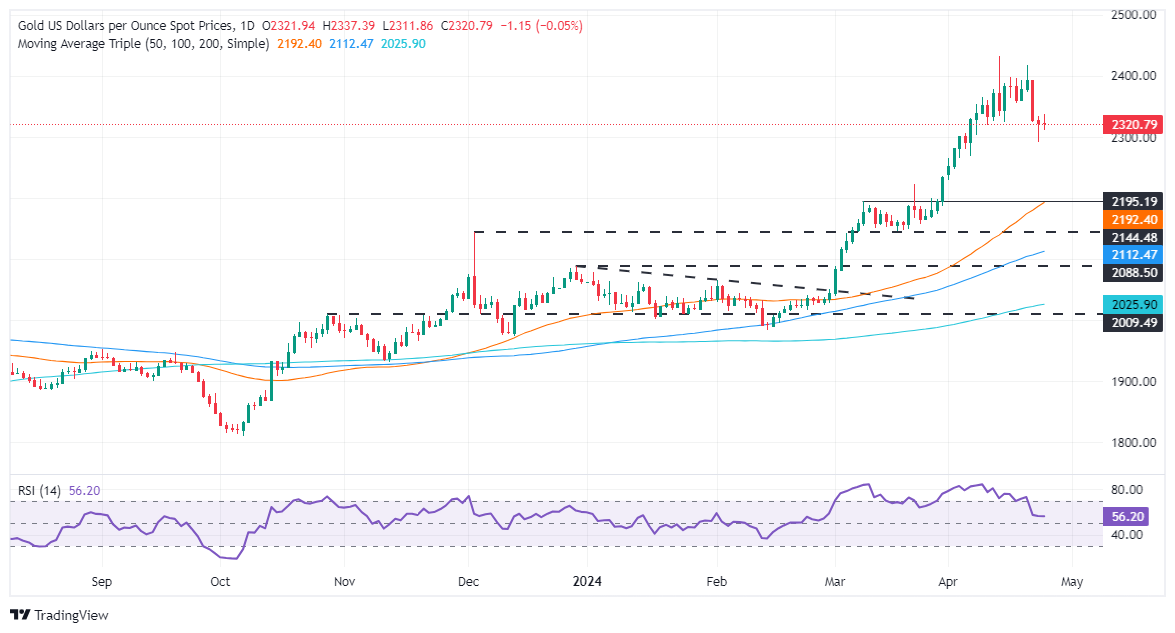Gold stays firm amid higher US yields as traders await US GDP data
- Gold recovers from recent losses, buoyed by market interest despite a stronger US Dollar and higher US Treasury yields.
- De-escalation of Middle East tensions contributed to increased market stability, denting the appetite for Gold buying.
- US Durable Goods Orders were solid, but expectations for Fed rate cuts shift to later in the year.
Gold recovered some ground on Wednesday after posting back-to-back negative sessions during the beginning of the week as geopolitical risks abated. Better-than-expected economic data from the United States (US), a strong US Dollar, and higher US Treasury yields were not an excuse for golden metal buyers, who stepped in to buy the latest dip. However, ahead of the Wednesday's close, the golden metal finished with losses.of 0.25%.
XAU/USD trades at $2,317,down 0.05%. The Middle East conflict seems to have de-escalated following the fire’s interchange between Iran and Israel. Expectations for a Federal Reserve (Fed) rate cut in June and July vanished as most market participants speculate that the fed funds rate will be lowered for the first time in September 2024.
The US Department of Commerce showed that March’s Durable Goods Orders rose above estimates and February’s numbers, while core sales missed projections but showed an improvement compared to the previous month.
Daily digest market movers: Gold trims its losses amid upbeat Durable Goods Orders report
- US Durable Goods Orders significantly increased in March, expanding by 2.6% MoM, up from a 0.7% rise previously and surpassing 2.5%. When excluding transportation, Durable Goods Orders rose by 0.2% MoM, which was an improvement over February's 0.1% increase but fell short of the 0.3% projected.
- Upcoming Q1 GDP data, core PCE inflation figures will offer additional insights into potential timing of Fed's interest rate reductions. The Fed’s preferred inflation gauge, the core Personal Consumption Expenditures (PCE) Price Index, is estimated to remain steadily at 0.3%. The annual core PCE rate is expected to ease to 2.6%, down from February's rate of 2.8%, indicating potential softening of inflation pressure.
- Tuesday’s softer-than-expected S&P Global PMI report in the US increased odds for July rate cut. Chris Williamson, Chief Business Economist at S&P Global Market Intelligence, wrote: “The US economic upturn lost momentum at the start of the second quarter, with the flash PMI survey respondents reporting below-trend business activity growth in April.” This could help to bring down stubbornly sticky inflation, which remains well above the Fed's 2% core target.
- Data from the Chicago Board of Trade (CBOT) suggests that traders expect the fed funds rate to finish 2024 at 4.98%, up from 4.965% on Tuesday.
- US 10-year Treasury benchmark rate climbs six basis points (bps) at 4.66%.
- US Dollar Index (DXY) is up 0.18% to 105.87.
Technical Analysis: Gold price stays firm below $2,320
Gold recovered some ground despite forming a “bearish engulfing” chart pattern, which opened the door for a pullback. Although buyers have the upper hand on Wednesday, they are not out of the woods yet. They must push Gold’s spot price above the April 19 low of $2,373, so they can remain hopeful of testing $2,400. Once achieved, the next stop would be Friday’s high of $2,417, followed by the all-time high of $2,431.
On the flip side, if XAU/USD prices dip below the April 15 daily low of $2,324, that would pave the way to test $2,300. A breach of the latter will expose the March 21 high at $2,222.

Gold FAQs
Gold has played a key role in human’s history as it has been widely used as a store of value and medium of exchange. Currently, apart from its shine and usage for jewelry, the precious metal is widely seen as a safe-haven asset, meaning that it is considered a good investment during turbulent times. Gold is also widely seen as a hedge against inflation and against depreciating currencies as it doesn’t rely on any specific issuer or government.
Central banks are the biggest Gold holders. In their aim to support their currencies in turbulent times, central banks tend to diversify their reserves and buy Gold to improve the perceived strength of the economy and the currency. High Gold reserves can be a source of trust for a country’s solvency. Central banks added 1,136 tonnes of Gold worth around $70 billion to their reserves in 2022, according to data from the World Gold Council. This is the highest yearly purchase since records began. Central banks from emerging economies such as China, India and Turkey are quickly increasing their Gold reserves.
Gold has an inverse correlation with the US Dollar and US Treasuries, which are both major reserve and safe-haven assets. When the Dollar depreciates, Gold tends to rise, enabling investors and central banks to diversify their assets in turbulent times. Gold is also inversely correlated with risk assets. A rally in the stock market tends to weaken Gold price, while sell-offs in riskier markets tend to favor the precious metal.
The price can move due to a wide range of factors. Geopolitical instability or fears of a deep recession can quickly make Gold price escalate due to its safe-haven status. As a yield-less asset, Gold tends to rise with lower interest rates, while higher cost of money usually weighs down on the yellow metal. Still, most moves depend on how the US Dollar (USD) behaves as the asset is priced in dollars (XAU/USD). A strong Dollar tends to keep the price of Gold controlled, whereas a weaker Dollar is likely to push Gold prices up.